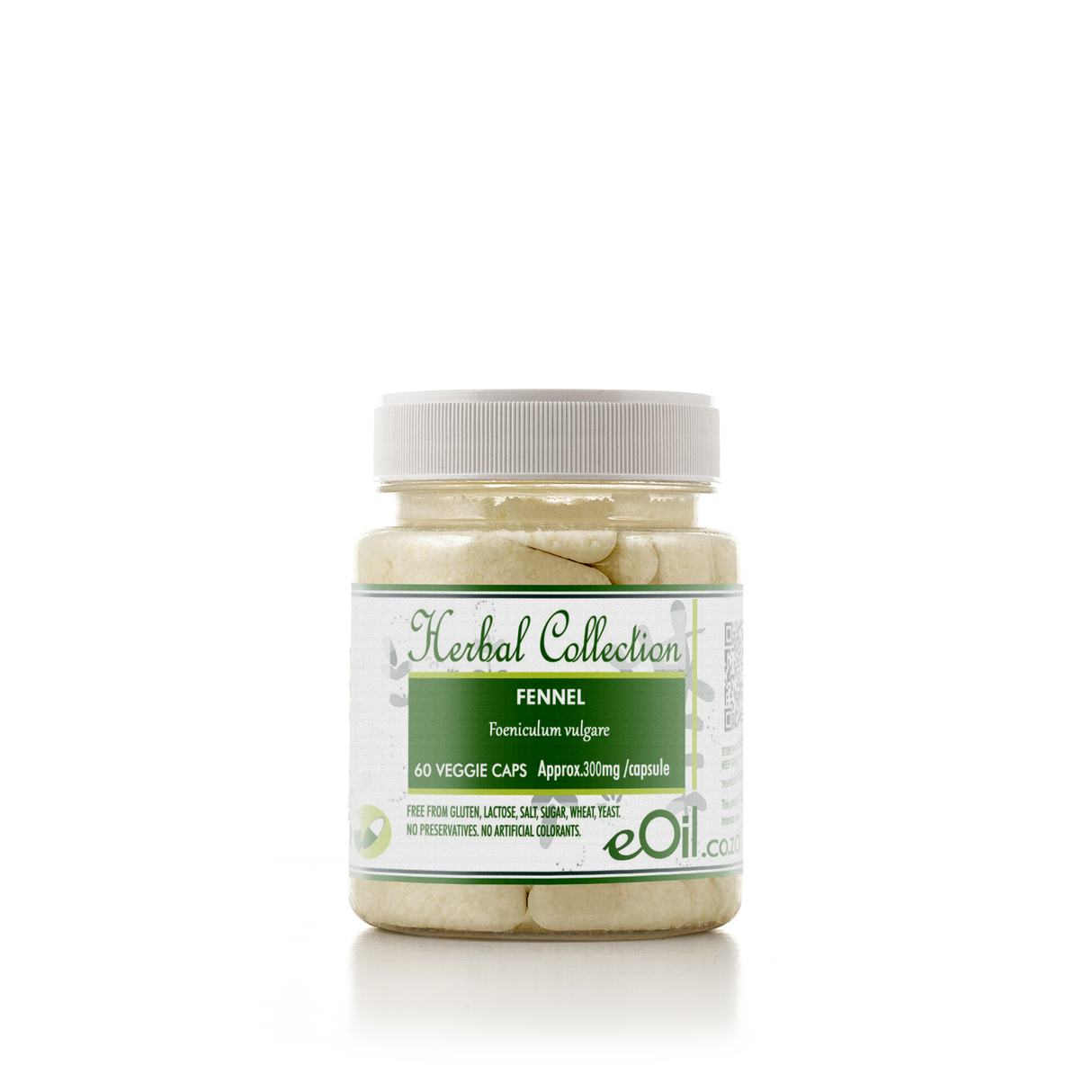Fennel Seed 60 Vegan Capsules - Herbal Collection
Fennel Seed 60 Vegan Capsules - Herbal Collection is backordered and will ship as soon as it is back in stock.
Description
Description
Fennel Seed 60 Vegan Capsules deliver pure, finely milled Foeniculum vulgare seed in plant-based capsules.
Traditionally valued for gentle digestive support and a mildly sweet, aromatic flavor, these capsules are convenient for daily herbal routines.
Free from additives, gluten, and animal products—perfect for natural wellness and vegan lifestyles
TRADITIONALLY USED FOR
Fennel Seed – Seeds, Tincture & Herbal Capsules (Foeniculum vulgare) – Product Description
What is Fennel Seed?
Fennel seeds are the aromatic, slightly sweet seeds of Foeniculum vulgare. They are widely used in culinary, herbal, and wellness traditions as a famous digestive aid and gentle hormonal and respiratory support.
Fennel also comes as tincture and convenient herbal capsules for diverse health applications.
Fennel Seeds (Whole/Dried)
Traditional & Modern Uses
- Digestive health: Relieves bloating, indigestion, gas, and spasms due to antispasmodic, carminative, and anti-inflammatory compounds (mainly anethole).
- Colic relief: Chewed or made into tea for calming infant colic (under guidance).
- Respiratory health: Supports the clearing of cough and phlegm.
- Lactation: May help stimulate milk production in nursing mothers.
- Natural breath freshener: Chew after meals for fresh breath.
How to Use
- Chew seeds after meals (½–1 teaspoon) for digestion and breath.
- Herbal infusion: Pour boiling water over 1–2 tsp crushed seeds, steep 5–10 minutes, strain, and enjoy after meals.
- Culinary: Use seeds whole or crushed to flavor breads, curries, and baked goods.
Basic COA Information
- Product: Dried fennel seeds (Foeniculum vulgare)
- Origin: South Africa/import; food grade, batch tested for purity
- Key compounds: Anethole, fenchone, fiber, minerals
- COA: Heavy metal and microbial purity tested
Fennel Tincture (Liquid Extract)
Traditional & Modern Uses
- Digestive and antispasmodic: Relieves bloating, gas, and cramps, especially after heavy meals or for colic.
- Hormonal support: May gently ease menstrual and menopausal symptoms.
- Respiratory: Expectorant action supports a clear chest during coughs and colds.
How to Use
- Standard dose: 15–60 drops (about 0.5–2 ml) in a small amount of water, up to 2–3 times daily, or as directed by a healthcare provider.
- Preparation: Traditionally made with fennel seeds soaked in vodka (1:2–1:5 seed:alcohol ratio), left to macerate for 1–4 weeks and strained.
Basic COA Information
- Botanical: Liquid extract of fennel (seeds, food grade alcohol or glycerin)
- Key markers: Anethole content, tested for contaminants
- Free from: Synthetic colors, flavors, preservatives, and major allergens
Fennel Herbal Capsules
Traditional & Modern Uses
- Convenience for digestive comfort: Alleviates indigestion, gas, and mild cramping.
- Hormonal and lactation support
- Respiratory calming: Traditionally used for cough and sore throat.
How to Use
- Typical dosage: 1–2 capsules (often 300–500 mg each, pure fennel seed powder) 1 to 2 times daily after food.
- Course: Suitable for up to 12-week cycles, with a week break before repeat use.
Basic COA Information
- Product: Dried fennel (Foeniculum vulgare) seed powder in vegan capsules
- Free from: Additives, major allergens, synthetic agents
- Food grade, batch tested for purity
Safety and Precautions (All Forms)
- Generally safe for most adults in culinary and therapeutic amounts.
- Not recommended during pregnancy in high/therapeutic doses or for young children without practitioner guidance.
- Allergic reactions possible (rare, usually in those with carrot/celery allergies).
- Fennel may interact with some medications; always consult a healthcare provider if you have allergies, hormone-sensitive conditions, or take chronic medication.
| Feature | Seeds | Tincture | Capsules |
|---|---|---|---|
| Key Actions | Antispasmodic, carminative | Fast-acting digestion, cramps | Digestive, convenient |
| Main Compounds | Anethole, fenchone, fiber | Anethole/flavonoids | Seed powder |
| Typical Dose | ½–1 tsp chew/tea | 15–60 drops, 2–3x/day | 1–2 caps, 1–2x/day |
| Warnings | Caution pregnancy, allergy | As above, avoid excess | As above |
Documentation & certification, visit the quality/certification page on eOil.co.za.
Not intended as a substitute for medical advice. Always consult a practitioner if unsure, on medication, or for persistent symptoms.
INFORMATION
Source : http://www.wikiphyto.org/wiki/Fenouil_doux
Reference on http://www.wikiphyto.org
Translation in English by Google Translate (go to the page of the source linked | on Chrome cellphones go on the 3 dots on the top right and select translate in your preferred language | on laptop right click your mouse and select option translate when hoovering on the page
plant name
- Sweet fennel ( dill fennel )
- bitter fennel
International Latin denomination
- Foeniculum vulgare Mill. var. sweetness
- Foeniculum vulgare var. vulgar
botanical family
Apiaceae ( Umbelliferae )
Description and habitat
- Herbaceous plant from the limestone hillsides of the Midi, with a strong aniseed smell
- Glaucous stem up to 2 m high, with leaves cut into filiform, pinnate, feathery strips
- Greenish-yellow flowers gathered in umbels
- Fruit: oblong +/- arched achene
History and tradition
- Part of the syrup of the five roots: Ache , Asparagus , Fennel , Parsley , Butcher's broom
- In the Middle Ages, it was used as an antidote against witchcraft
- Two varieties are described, Foeniculum vulgare var. amara (to fenchone ) and var. dulce (to anethole and estragole )
Parts used
- Fruit, root, leaf
- Seed essential oil (fruit)
Dosage forms available
- Seed tincture (fruit)
- Aerial part essential oil
Usual dosages
Composition
Main components of the plant
- Fruits of the sweet variety Foeniculum vulgare var. sweet :
- Essential oil (2 to 6%) rich in E-anethole (= trans-anethole 80%) methyl-chavicol = estragole (5 - 10%) and fenchone (< 2%)
- Coumarins : scopoletin , bergapten , umbelliferone
- Diosgenin
- There are two chemotypes : anethole and estragole .
- Root: flavonoids ( kaemferol , quercetin , isorhamnetin ), organic acids , coumarins ( umbelliferone )
Main components of buds or young shoots
Main components of essential oil
- Phenol methyl ethers : trans-anethole = E-anethole (55-75% in Fœniculum vulgare var. amara , 80-95% in Fœniculum vulgare var. dulce ), methyl-chavicol = estragole (5 - 10%)
- Ketone : fenchone (12-25% in Fœniculum vulgare var. amara , 1-10% in Fœniculum vulgare var. dulce )
- Alpha-pinene 1-10% (in Foeniculum vulgare var. amara )
- Two chemotypes are described : anethole and estragole .
Properties
Plant properties
- Root: diuretic (syrup of the five roots), the herbal tea is much less active, you need a hydro-alcoholic extract (Fleurentin)
- Leaf: vulnerary
- Fruit: carminative, galactagogue and eupeptic, expectorant
- Anti-inflammatory, anti-allergic, by inhibition of 5-lipoxygenase [1]
- Stimulates stomach motility by mouth
- Galactogen (seed and essential oil)
- The plant (hydro-alcoholic extract) improves fertility in mice (presence of diosgenin ) [2]
- Anethole is estrogen -like but total essential oil is more active. It increases the glandular secretions at the respiratory level by direct action on the cells or by stimulation of the glands of the gastric mucosa. This causes an evacuation of the bronchial mucus
Bud properties
Properties of essential oil
- Galactogenic, estrogen-like ( anethole ) [3] , estrogenic effect is related to polymers of anethole ( dianethole and photoanethole ) [4]
- Powerfully antispasmodic
- Anxiolytic [5]
- Nerve, respiratory and cardiac tonic
- Depurative, eupeptic, stomachic, aperitif, cholagogue, choleretic, carminative, improves colic in children in a randomized study against placebo [6]
- Hepatoprotective [7]
- Analgesic, anti-inflammatory [8]
- Antifungal (dermatophytes Trichophyton rubrum , Trichophyton tonsurans , Microsporum gypseum , Trichophyton mentagrophytes ) [9] , [10]
- Antioxidant, comparable to tocopherol [11]
- Antithrombotic, broad-spectrum antiplatelet activity, and vasorelaxant action ( anethole ) [12]
- Miticide [13]
Directions
Indications of the whole plant (phytotherapy)
- Bloating, gastralgia
- Cholelithiasis
- Breastfeeding (stimulates)
- Anxiety and depression in postmenopausal women [14]
- Postmenopausal vaginal atrophy by local route in the form of a cream, significantly increases the index of vaginal maturation and the number of superficial cells [15] , but not by oral route [16]
- Locally: blepharitis, conjunctivitis
- A cream with fennel extract dosed at 2% is effective on female hirsutism [17]
Indications of the bud (gemmotherapy)
Specific indications of essential oil (aromatherapy)
- Insufficient breastfeeding
- Amenorrhea, symptoms of premenopause and menopause
- Neuromuscular spasms, lumbago, rheumatism
- Bronchitis, asthma, spastic cough
- Dyspepsia, aerophagia, hiccups, nausea, flatulence, colitis, gastralgia, anorexia
- Stress, nervous asthenia
Known or suspected mode of action
- Vulnerary comes from “vulnus -eris wound => vulnerarius = suitable for healing wounds
- Anethole is central analgesic , increases pulmonary secretions, stimulates expectoration, estrogen-like, stimulates liver regeneration after partial hepatectomy, antithrombotic
Usual formulations
- Herbal tea called "five roots" (diuretic):
- Wild fennel roots ( Fœniculum vulgare )
- Ache roots ( Apium graveolens )
- Asparagus roots ( Asparagus officinalis )
- Parsley roots ( Petroselinum sativum )
- Small holly roots ( Ruscus aculeatus ) ... to 30 grams
- Take two teaspoons (about 10 grams) for 1/2 liter of water, boil for a few minutes, infuse for half an hour, filter. Drink during the day, 4 days a week
- Galactogenic herbal tea:
- Angelica Angelica archangelica seeds...30 grams
- Green anise Pimpinella anisum seeds...30 grams
- Fennel Foeniculum vulgare seeds ... 30 grams
- Caraway Carum caraway seeds...60 grams
- Hops Humulus lupulus cones ... 20 grams
- One teaspoon per cup. Boil 2 to 3 minutes, infuse 10 minutes. Drink 2 to 3 cups a day
Regulations
- French Pharmacopoeia list A (fruit of sweet fennel and bitter fennel , underground part of sweet fennel )
Possible side effects and precautions for use
- HE not recommended for pregnant women
- Prolonged use of fennel can cause premature breast enlargement in little girls ( thelarche ) [18]
- Caution in case of hypothyroidism ( HE )
- Avoid association with anticoagulants or antiaggregants
- No prolonged use
- Essential oil formally contraindicated in hormone-dependent cancer pathologies
Bibliographic references
- Aller↑ Lee JH, Lee DU, Kim YS, Kim HP. 5-Lipoxygenase Inhibition of the Fructus of Foeniculum vulgare and Its Constituents. Biomolecules & Therapeutics. 2012;20(1):113-117. doi:10.4062/biomolther.2012.20.1.113. Full Text
- Aller↑ Khazaei M, Montaseri A, Khazaei MR, Khanahmadi M. Study of Foeniculum vulgare Effect on Folliculogenesis in Female Mice. International Journal of Fertility & Sterility. 2011;5(3):122-127. [1]
- Aller↑ Howes MJ, Houghton PJ, Barlow DJ, Pocock VJ, Milligan SR. Assessment of estrogenic activity in some common essential oil constituents. J Pharm Pharmacol. 2002 Nov;54(11):1521-8. PMID 12495555
- Aller↑ Albert-Puleo M. Fennel and anise as estrogenic agents. J Ethnopharmacol. 1980 Dec;2(4):337-44. PMID 6999244
- Aller↑ Mesfin M, Asres K, Shibeshi W. Evaluation of anxiolytic activity of the essential oil of the aerial part of Foeniculum vulgare Miller in mice. BMC Complement Altern Med. 2014 Aug 23;14:310. doi: 10.1186/1472-6882-14-310. PMID 25149087
- Aller↑ Alexandrovich I, Rakovitskaya O, Kolmo E, Sidorova T, Shushunov S. The effect of fennel (Foeniculum vulgare) seed oil emulsion in infantile colic: a randomized, placebo-controlled study. Altern Ther Health Med. 2003 Jul-Aug;9(4):58-61. PMID 12868253
- Aller↑ H. Özbek, S. Ura, H. Dülger, Bayram, Tuncer, G. Öztürk, A. Öztürk. Hepatoprotective effect of Foeniculum vulgare essential oil. Fitoterapia, Volume 74, Issue 3, April 2003, Pages 317-319 full text
- Aller↑ Eun-Mi Choi and Jae-Kwan Hwang. Antiinflammatory, analgesic and antioxidant activities of the fruit of Foeniculum vulgare. Fitoterapia, Volume 75, Issue 6, September 2004, Pages 557-565
- Aller↑ Zeng H, Chen X, Liang J. In vitro antifungal activity and mechanism of essential oil from fennel (Foeniculum vulgare L.) on dermatophyte species. J Med Microbiol. 2015 Jan;64(Pt 1):93-103. doi: 10.1099/jmm.0.077768-0. PMID 25351709
- Aller↑ Gurdip Singh, Sumitra Maurya, MP de Lampasona, C. Catalan. Chemical constituents, antifungal and antioxidant potential of Foeniculum vulgare volatile oil and its acetone extract. Food Control, Volume 17, Issue 9, September 2006, Pages 745–752
- Aller↑ Ruberto, G., Baratta, MT, Deans, SG, & Dorman, HD (2000). Antioxidant and antimicrobial activity of Foeniculum vulgare and Crithmum maritimum essential oils. Plantamedica, 66(08), 687-693.
- Aller↑ Tognolini M, Ballabeni V, Bertoni S, Bruni R, Impicciatore M, Barocelli E. Protective effect of Foeniculum vulgare essential oil and anethole in an experimental model of thrombosis. Pharmacol Res. 2007 Sep;56(3):254-60. PMID 17709257
- Aller↑ Lee HS. Acaricidal activity of constituents identified in Foeniculum vulgare fruit oil against Dermatophagoides spp. (Acari: Pyroglyphidae). J Agric Food Chem. 2004 May 19;52(10):2887-9. PMID 15137830
- Aller↑ Ghazanfarpour M, Mohammadzadeh F, Shokrollahi P, Khadivzadeh T, Najaf Najafi M, Hajirezaee H, Afiat M. Effect of Foeniculum vulgare (fennel) on symptoms of depression and anxiety in postmenopausal women: a double-blind randomized controlled trial. J Obstet Gynecol. 2018 Jan;38(1):121-126. doi: 10.1080/01443615.2017.1342229. PMID 28891367
- Aller↑ Yaralizadeh M, Abedi P, Najar S, Namjoyan F, Saki A. Effect of Foeniculum vulgare (fennel) vaginal cream on vaginal atrophy in postmenopausal women: A double-blind randomized placebo-controlled trial. Maturitas. 2016 Feb;84:75-80. doi: 10.1016/j.maturitas.2015.11.005. PMID 26617271
- Aller↑ Ghazanfarpour M, Shokrollahi P, Khadivzadeh T, Baharian Sharghi N, Mirzaii Najmabadi K, Babakhanian M, Jafarian AHEffect of Foeniculum vulgare (fennel) on vaginal atrophy in postmenopausal women: A double-blind, randomized, placebo-controlled trial. Post Reprod Health. 2017 Dec;23(4):171-176. doi: 10.1177/2053369117733629. PMID 28990439
- Aller↑ Javidnia K, Dastgheib L, Mohammadi Samani S, Nasiri A. Antihirsutism activity of Fennel (fruits of Foeniculum vulgare) extract. A double-blind placebo controlled study. Phytomedicine. 2003;10(6-7):455-8. PMID 13678227
- Aller↑ Türkyilmaz Z, Karabulut R, Sönmez K, Can Başaklar A. A striking and frequent cause of premature thelarche in children: Foeniculum vulgare. J Pediatric Surg. 2008 Nov;43(11):2109-11. doi: 10.1016/j.jpedsurg.2008.07.027. PMID 18970951
- Aviessi F. Dangou J. Wotto V. Alitonou G. Sohounhloue D. Menut Chantal. Antioxidant properties of the essential oil of the leaves of Clausena anisata (Wild) Hook. Chemistry reports. 2004, vol. 7, no.10-11, pp. 1057-1061
- Zeller A, Horst K, Rychlik M. Study of the metabolism of estragole in humans consuming fennel tea. Chem Res Toxicol. 2009 Dec;22(12):1929-37. doi: 10.1021/tx900236g. PMID 19908891
CAUTION
Store in a cool, dry place, away from light. Keep tightly closed, away from the reach of Children and pets.
Do not exceed the daily dose.
This product is not intended to prevent or cure any form of illness or disease.
If you are pregnant or nursing ; If you have a medical condition or are in the course of medical treatment ; If you are programmed for theater/operation in the near future, please consult your healthcare practitioner before using this product.
This product cannot replace a varied and balanced diet and a healthy lifestyle.
This product has not been evaluated by the SAHPRA for its quality, safety or intended use.
For More Information please check our General Safety Herbal products Page

Fennel Seed 60 Vegan Capsules - Herbal Collection is backordered and will ship as soon as it is back in stock.





